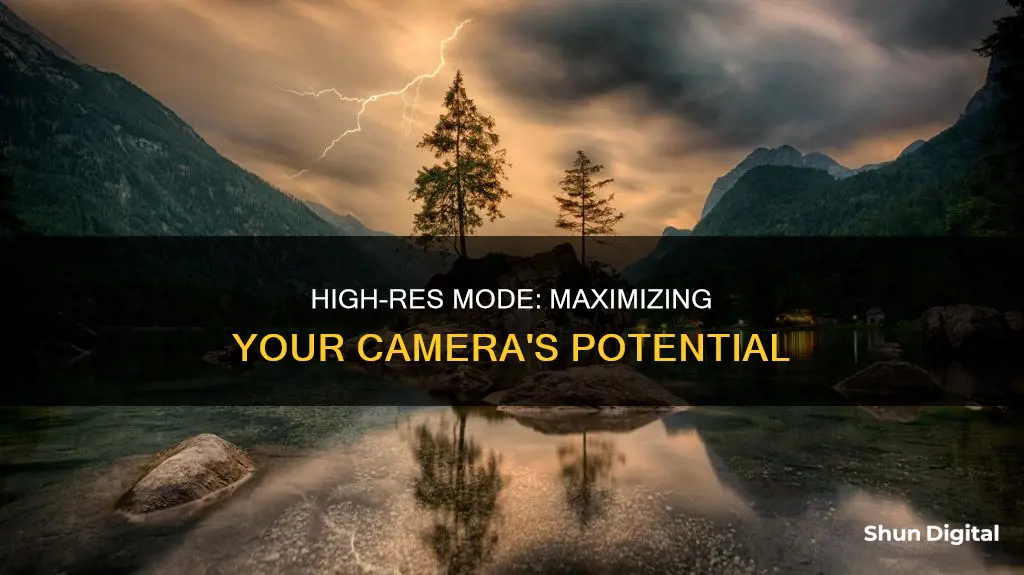
High-resolution mode, also known as high-res mode, is a feature on some cameras that allows photographers to capture images with a higher pixel count than the native resolution of the camera's sensor. This mode is made possible by in-body image stabilization (IBIS), which enables the camera's sensor to move very slightly between each shot, capturing multiple images that can then be combined to create a single, high-resolution image. The number of images captured and the amount of sensor movement between each shot vary depending on the camera model and the specific high-res mode being used. For example, the Panasonic Lumix G9's high-resolution mode captures eight images with the sensor shifted by half-pixel increments between each shot, resulting in an 80MP final image.
High-res mode is particularly useful for photographers who want to create large prints with a high level of detail. It is best suited for photographing static scenes and objects, as movement between shots can create blurring or pixelation in the final image. Some cameras, such as the Olympus OM-1, offer a handheld high-res mode that can compensate for small amounts of camera movement, making it more versatile for shooting scenes with some movement.
| Characteristics | Values |
|---|---|
| Purpose | To capture incredibly detailed images |
| Image Resolution | Up to 80MP |
| Sensor Movement | Half-pixel increments |
| Number of Exposures | 8 |
| File Format | JPEG, RAW |
| Limitations | Requires a tripod, unsuitable for moving subjects |
What You'll Learn
- High-res mode increases the resolution of images by combining multiple exposures into a single high-megapixel image
- The feature is best suited for static scenes and objects as each exposure needs to look almost identical
- The technology has been made possible by in-body image stabilisation (IBIS)
- The primary purpose of IBIS is to compensate for the accidental movements that occur when hand-holding a camera
- The Olympus OM-D E-M1 Mark II and Panasonic Lumix DC-G9 are examples of cameras that offer high-res mode

High-res mode increases the resolution of images by combining multiple exposures into a single high-megapixel image
High-res mode is a feature on some cameras that allows photographers to capture incredibly detailed images with a higher resolution than the camera's sensor would usually allow. This is achieved by combining multiple exposures into a single high-megapixel image.
The high-res mode is made possible by in-body image stabilisation (IBIS), which compensates for accidental camera movements and enables the capture of sharp images at slower shutter speeds. The IBIS system detects camera shake and makes tiny adjustments to the sensor to correct the image and prevent blurring.
The sensor can also be moved very precisely, which enables another feature known as Pixel Shift Multi-Shot mode or High Res Shot mode. When this mode is activated, the camera captures a series of images, shifting the sensor slightly between each shot. These images can then be combined to create a single high-resolution image with more detail.
The Olympus OM-D E-M1X, OM-1 and OM-5, for example, feature two modes: one for use with a tripod and stationary subjects, and another that can handle some subject movement and handheld shooting. In tripod mode, these cameras produce 80MP images, while in handheld mode they produce 50MP images.
The high-res mode has several advantages, including improved noise reduction, moiré reduction and increased overall resolution. However, it also has some limitations. As multiple images are required, the process takes longer and is therefore less suitable for moving subjects. It also usually requires the use of a tripod to keep the camera stable.
Converting Camera Raw Files to JPEGs: A Step-by-Step Guide
You may want to see also

The feature is best suited for static scenes and objects as each exposure needs to look almost identical
The high-resolution mode in cameras is a feature that allows photographers to capture images with a higher pixel count than the native resolution of the camera's sensor. This is achieved by shifting the sensor in small increments and taking multiple shots, which are then merged to create a single high-resolution image. This mode is particularly well-suited for static scenes and objects, as each exposure needs to be nearly identical for the final image to turn out well.
The high-resolution mode was first introduced by Hasselblad in its H4D-200MS camera and has since been adopted by other manufacturers, including Olympus, Panasonic, Pentax, and Sony. The Olympus OM-D E-M1 Mark II, for instance, can produce 50MP images in handheld mode and 80MP images when mounted on a tripod. Similarly, the Panasonic Lumix DC-G9 can generate 80MP images using its high-resolution mode.
One of the main advantages of using high-resolution mode is the ability to capture finer details and colours in static scenes. It also helps reduce noise and moiré patterns in images. However, this mode is not suitable for photographing moving subjects, as each exposure needs to be nearly identical, and any movement will result in blurring or pixelation. Additionally, using this mode typically requires a longer exposure time, making it essential to use a tripod to minimise camera shake.
While high-resolution mode has its limitations, it can be a valuable tool for certain types of photography, such as still life and static landscapes. As the technology continues to evolve, we can expect improvements that may eventually allow for handheld shooting and better handling of moving subjects.
Charging the Polaroid Snap Touch: A Step-by-Step Guide
You may want to see also

The technology has been made possible by in-body image stabilisation (IBIS)
In-body image stabilization (IBIS) is a feature of mirrorless cameras that reduces blur caused by camera shake. It works by moving the camera sensor slightly to counter any movement. This is in contrast to in-lens stabilization, where an additional lens element moves to ensure a stable image on the sensor.
IBIS is particularly useful when shooting handheld, as it allows photographers to use slower shutter speeds without introducing blur from camera shake. This can be a big advantage in low-light situations, as it means photographers can avoid increasing the ISO or aperture to achieve a sharper image.
IBIS also has the benefit of working with any lens, even those that weren't originally designed with stabilization. This gives photographers more flexibility when choosing lenses and can simplify the design of shorter focal-length lenses.
The technology has been made possible by in-body image stabilization (IBIS). IBIS is a feature found in some mirrorless cameras that compensates for accidental camera movements when hand-holding the device. It works by detecting camera shake and making tiny adjustments to the sensor to correct it, resulting in sharp images even at slower shutter speeds.
IBIS enables the camera sensor to be moved with high precision, allowing for the creation of high-resolution images. By shifting the sensor by small amounts, typically half the width of a pixel, between each shot, multiple images can be combined to form a larger, more detailed final image. This process, known as Pixel Shift Multi-Shot mode or High Res Shot mode, is now available in cameras from brands like Fujifilm, Olympus, Panasonic, Pentax, and Sony.
The IBIS system's ability to precisely move the sensor is key to enabling high-resolution mode. By making slight adjustments to the sensor's position, it becomes possible to capture multiple images that can be combined to create a single, high-resolution photograph. This technology empowers photographers to capture incredibly detailed images, pushing the boundaries of what was previously possible.
Charging Spy Button Cameras: A Step-by-Step Guide
You may want to see also

The primary purpose of IBIS is to compensate for the accidental movements that occur when hand-holding a camera
In-body image stabilisation (IBIS) is a relatively new technology in cameras that stabilises the sensor to provide both stable, shake-free video footage and sharp still images when shooting handheld at longer shutter speeds. The primary purpose of IBIS is to compensate for the accidental movements that occur when hand-holding a camera and, therefore, enable sharp images to be captured when using slower shutter speeds than normal.
IBIS, also known as sensor shift technology, works by physically moving the sensor inside your camera to compensate for camera movement. Built-in gyroscopes and accelerometers calculate the motion and rotation of your camera and move the sensor accordingly to keep the image stable.
IBIS works by detecting camera shake and shifting the sensor by tiny amounts to correct it so that the image isn't blurred. The precision with which the sensor can be moved enables another feature, usually called Pixel Shift Multi-Shot mode or High Res Shot mode. When this mode is activated, the camera takes a series of images, shifting the sensor slightly between each shot. These images can then be combined into one image to either create a larger, high-resolution image with more detail or an image with the same pixel count as normal but with slightly better detail, colour and tonal gradations.
IBIS is particularly useful for handheld video recording and can produce excellent quality footage. It is also useful for low-light photography, as it enables photographers to use slower shutter speeds without introducing camera shake.
Mastering AV Mode: Creative Control for Photographers
You may want to see also

The Olympus OM-D E-M1 Mark II and Panasonic Lumix DC-G9 are examples of cameras that offer high-res mode
The Olympus OM-D E-M1 Mark II and Panasonic Lumix DC-G9 are both mirrorless cameras with a 20-megapixel sensor and in-body image stabilisation (IBIS) systems. The IBIS system compensates for accidental camera movements, enabling sharper images to be captured when using slower shutter speeds. This precise sensor movement also enables high-res mode.
The Olympus OM-D E-M1 Mark II was released in September 2016, followed by the Panasonic Lumix DC-G9 in November 2017. The Lumix offers a higher resolution electronic viewfinder than the OM-D (3680k dot vs 2360k dot) and a higher continuous shooting speed (20fps vs 15fps). The OM-D is lighter (574g vs 658g) and smaller in its external dimensions.
Both cameras have fully-articulating 3.00" screens and are resistant to water and dust. They also have the same Micro Four Thirds lens mount and are compatible with the same lenses.
Charging the Explore One HD Camera: A Quick Guide
You may want to see also
Frequently asked questions
High Res Mode, or High-Resolution Mode, is a feature on some cameras that allows photographers to capture images with a higher resolution than the native resolution of the camera's sensor.
High Res Mode works by taking multiple images and shifting the sensor by a small amount between each image. These images are then combined to create a single high-resolution image.
High Res Mode can result in images with higher resolution, improved colour accuracy, reduced noise, and reduced moire.
High Res Mode requires the camera to take multiple images, so it is not suitable for capturing moving subjects. It also typically requires the use of a tripod to prevent camera movement between each image.
High Res Mode is available on a range of cameras from different manufacturers, including Olympus, Panasonic, Pentax, Sony, and Fujifilm.







